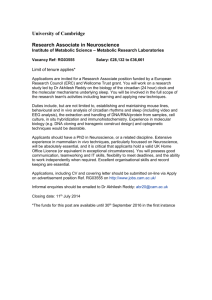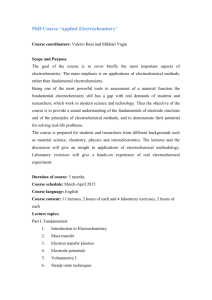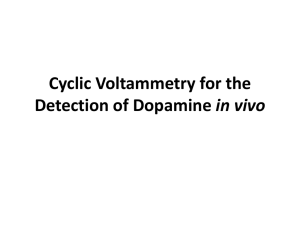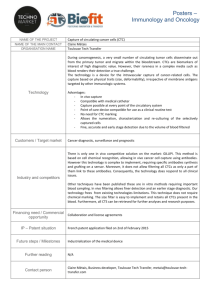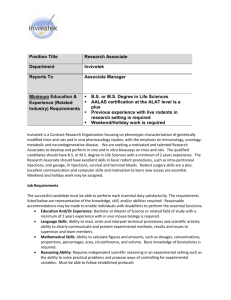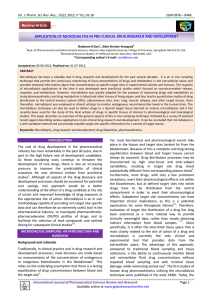Monitoring molecules in neuroscience: historical overview and
advertisement
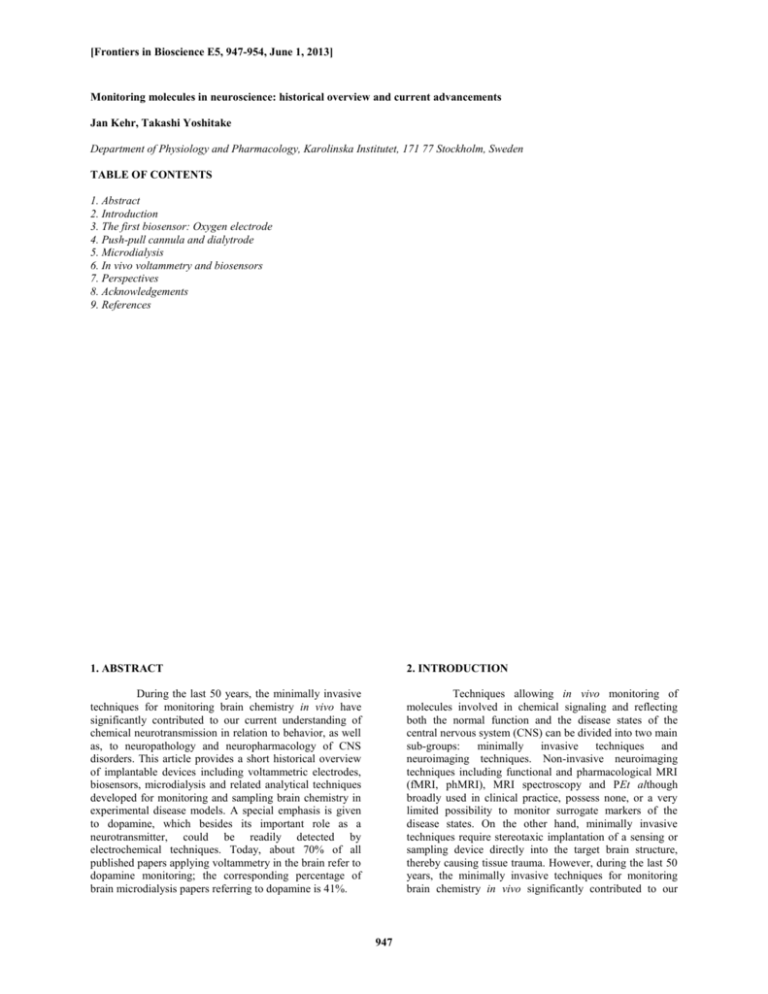
[Frontiers in Bioscience E5, 947-954, June 1, 2013] Monitoring molecules in neuroscience: historical overview and current advancements Jan Kehr, Takashi Yoshitake Department of Physiology and Pharmacology, Karolinska Institutet, 171 77 Stockholm, Sweden TABLE OF CONTENTS 1. Abstract 2. Introduction 3. The first biosensor: Oxygen electrode 4. Push-pull cannula and dialytrode 5. Microdialysis 6. In vivo voltammetry and biosensors 7. Perspectives 8. Acknowledgements 9. References 1. ABSTRACT 2. INTRODUCTION During the last 50 years, the minimally invasive techniques for monitoring brain chemistry in vivo have significantly contributed to our current understanding of chemical neurotransmission in relation to behavior, as well as, to neuropathology and neuropharmacology of CNS disorders. This article provides a short historical overview of implantable devices including voltammetric electrodes, biosensors, microdialysis and related analytical techniques developed for monitoring and sampling brain chemistry in experimental disease models. A special emphasis is given to dopamine, which besides its important role as a neurotransmitter, could be readily detected by electrochemical techniques. Today, about 70% of all published papers applying voltammetry in the brain refer to dopamine monitoring; the corresponding percentage of brain microdialysis papers referring to dopamine is 41%. Techniques allowing in vivo monitoring of molecules involved in chemical signaling and reflecting both the normal function and the disease states of the central nervous system (CNS) can be divided into two main sub-groups: minimally invasive techniques and neuroimaging techniques. Non-invasive neuroimaging techniques including functional and pharmacological MRI (fMRI, phMRI), MRI spectroscopy and PEt although broadly used in clinical practice, possess none, or a very limited possibility to monitor surrogate markers of the disease states. On the other hand, minimally invasive techniques require stereotaxic implantation of a sensing or sampling device directly into the target brain structure, thereby causing tissue trauma. However, during the last 50 years, the minimally invasive techniques for monitoring brain chemistry in vivo significantly contributed to our 947 Monitoring molecules in neuroscience current understanding of chemical neurotransmission in relation to behavior, as well as, to neuropathology and neuropharmacology of CNS disorders. using a membrane or a semi-permeable coating of some kind to protect the sensor from interferents in the complex biological matrices. Among many bio-applications of oxygen monitoring, there is an interesting opportunity to carry out regional brain oxygen recordings in freely moving animals using chronically implanted oxygen electrodes and performing various behavioral tasks and to correlate these measures to functional MRI (measures changes in oxygenated hemoglobin – blood flow) findings in rodents (13), and possibly to non-human primates and humans. Thus, the Clark oxygen electrode may allow for translational studies related complex behavior. Several monographs and book chapters on in vivo monitoring techniques in neurosciences have been edited (1-8). In 1982, Prof. C. Marsden initiated a series of meetings with emphasis on electrochemical detection and in vivo methods in neuropharmacology. Gradually, the meetings grew into an international conference on "Monitoring Molecules in Neuroscience," which is organized every second year. The proceedings of the conferences provide a fast overview on major application areas and technological advancements of in vivo monitoring techniques. 4. PUSH-PULL CANNULA AND DIALYTRODE The successful development of devices for continuous monitoring of gaseous molecules and their neuro-applications was followed up by a proposal of Sir John Henry Gaddum (1900-1965) who constructed an implantable mini-perfusion device, a push-pull cannula (14, 15). This device allowed in vivo sampling and monitoring of neurochemical markers relevant to disease and metabolic states, thereby complementing the already existing in vitro techniques used for brain slices or synaptosomal preparations. Among several construction variants of the cannula, the one based on the concentric design by Myers, 1970 (16) has probably been the one most commonly used until recently. In spite of the initial concern about the performance of the push-pull cannula (17), inducing severe tissue damage and highly variable data, a number of papers were published in prominent journals reporting the applicability of the technique to sample proteins (18) and the release of pre-loaded radiolabeled neurotransmitters, noradrenaline (NA), (19), and DA and GABA by Glowinski and collaborators (20-23). This article provides a short historical overview of implantable devices and related techniques developed for monitoring and sampling brain chemistry and in particular, dopamine (DA) in experimental disease models. 3. THE FIRST BIOSENSOR: OXYGEN ELECTRODE The very first and unarguably still the most important biosensor device developed for monitoring molecules in the biological systems was the oxygen electrode constructed and patented in 1954 by Leland C. Clark (1918-2005). The electrode allows continuous realtime recording of blood oxygen tension by polarography (9,10) in patient´s blood, a technique that dramatically improved the safety of patients during surgery and other conditions associated with risk of hypoxia. The Clark oxygen electrode is based on reduction of molecular oxygen on a platinum electrode and amperometric measuring of the current in the reductive mode following a two-step reaction: The use of the push-pull cannula for monitoring neurotransmitter release was successively replaced by implementing the technically easier and commercially available microdialysis technique (described below). Initially, the push-pull cannula was equipped with a dialysis bag on its tip as described by Delgado and co-workers (24). Jose Manuel Rodriguez Delgado (1915-2005) constructed and patented “a fluid-conducting instrument which could be inserted into living organisms” in 1969 (US patent 3,640,269). However, the “dialytrode” technique failed to reproduce the earlier data obtained with push-pull ”chemitrodes” (25) and less than ten papers were published using the dialytrode technology. Delgado focused on studies (many of them ethically questionable from today´s perspective) on the use of stimulation electrodes implanted in specific brain structures. Thus, Delgado contributed to the development of clinical applications of neurostimulation as summarized in his visionary paper from 1977 (26). Implantable neurostimulatory electrodes are currently used, for example, in deep brain stimulation (DBS) therapy of Parkinson´s disease and chronic pain and are conceptually evaluated for interfacing brain-machine communication (for review, see 27). O2 + 2 e¯ + 2 H2O → H2O2 + 2 OH¯ H2O2 + 2 e¯ → 2 OH¯ Clark´s revolutionary idea was to protect the Pt electrode assembly with a semi-permeable membrane, thereby allowing only small molecules including dissolved O2 to penetrate from the complex (biological) environment and protect the electrode, e.g. from protein fouling. The first report on successful measurement of cerebral oxygenation in mongrel dogs using the Clark electrode was published by McLaurin and colleagues in 1959 (11). In the same year, Ingvar et al., 1959 (12) described a method for monitoring brain tissue carbon dioxide using a potentiometric sensor, constructed from a classical glass-membrane pH electrode placed in a narrow chamber with solution of NaHCO3 and a Teflon membrane permeable only to CO2 and other gases, but not to the ions. The effects of inhalation gases, nembutal and other conditions on CO2 and EEG responses were studied in the cortex of cats. Both the amperometric and potentiometric electrodes currently used for monitoring gases in blood, physiological media, and other biological samples including brain incorporate the Clark´s seminal idea of Interestingly, the concept of push-pull cannula sampling of brain chemistry regained its actuality in line 948 Monitoring molecules in neuroscience with current advancements in miniaturized devices (MEMS), lab-on-a-chip and micro total analysis systems (µTAS). of ions within the extracellular space (brain microenvironment) is driven predominantly by diffusion (33, 34). In an analogous way, the driving force of microdialysis sampling is diffusion of molecules across the concentration gradients existing between the brain and the perfusate compartments separated by the membrane. Thus, the molecules can move in both directions, which allows simultaneous recovery of endogenous compounds released into the brain microenvironment and at the same time, drugs can be delivered locally through the probe into the sampled area. Recently, a miniaturized push-pull microperfusion device was described by Kennedy and collaborators (28, 29). The advantage of using push-pull cannula was demonstrated particularly in combination with the segmented-flow perfusion system coupled to capillary electrophoresis with fluorescence detection for ultra-rapid determination of amino acid neurotransmitters. Likewise, sampling large molecules such as cytokines, trophic factors and other proteins and peptides by microdialysis requires a “pushpull-like” approach, i.e. using the membranes with large (>100 kDa) molecular cut-off and a push-pull perfusion system comprising either a dual-tube peristaltic pump or two syringe pumps operating in a push and pull mode (30). Rapid advancements in development of new separation (reversed-phase silica) materials and HPLC instrumentation including electrochemical and fluorescence detectors during the following years accelerated the research and applications of microdialysis in experimental neuropharmacology (35-37), as well as in the clinic (3840). Today, more than 14 000 references on microdialysis can be found in the PubMed database. A major advantage of using microdialysis is the possibility of sampling and monitoring all soluble molecules present in the extracellular fluid which are capable of diffusing across the membrane of the dialysis probe. Multiple transmitters, metabolites and other related molecules can be determined in the same sample providing that sensitive analytical techniques are available (for review, see 5). Microdialysis, compared to voltammetry and biosensors, offers rather poor temporal and spatial resolution, typical sampling intervals being between 5 - 20 min, and the length of the microdialysis membrane varies from 0.5 to 3 mm with its outside diameter ranging from 0.2 - 0.5 mm. However, for the majority of pharmacological studies, these features are satisfactory and microdialysis allows monitoring of basal, stimulated and even attenuated levels of extracellular neurotransmitters and for measuring DA in the brain structures which are generally inaccessible for voltammetric techniques due to their limited sensitivity and specificity. Typical examples are prefrontal cortex and other cortical areas, the hippocampus and the amygdala, which all are highly relevant brain structures to study the pathophysiology of many psychiatric and neurodegenerative disorders. 5. MICRODIALYSIS The first application of dialysis for sampling soluble molecules from the brain microenvironment was described by Bito at collaborators in 1966 (31). Mongrel dogs were implanted with sterile dialysis sacs in the cortex and subcutaneously in the neck and removed ten weeks later. The content of the sacs was analyzed for amino acids and ions and compared to the concentrations in plasma and CSF. For most of the amino acids, there was a concentration gradient of the order: blood plasma > extracellular fluid > CSF. A possibility of measuring timely changes in concentrations of radiolabeled precursors of amino acids and catecholamines in the monkey brain by use of a push-pull cannula equipped with a membrane on its tip (“a dialytrode”) was first reported by Delgado and co-workers (24) as already mentioned in section 4. The authors described some conceptual experiments, derived from the established protocols for push-pull experiments: infusing compounds into the brain and correlating the effects to brain electrical activity. Alternatively, labeled precursors were infused in order to estimate the rate of synthesis of labeled neurotransmitters. However, the Delgado´s dialytrode technique failed to detect the synthesis of amino acids following pre-loading with radioactive precursors and there was no detectable DA in the perfusates after pre-loading the brain with 14C-labeled L-DOPA (24). A possible explanation for this failure could be a poor performance of the analytical techniques used at that time and a limited availability of materials available for construction of a miniaturized sampling cannula-such as currently available fused-silica, thin hollow-fiber membranes and precision syringe pumps, all the devices that allow miniaturization of the dialysis probe. 6. IN VIVO VOLTAMMETRY AND BIOSENSORS Historically, the development of techniques for electrochemical monitoring of neurotransmitters and related molecules in the brain was initiated and developed by analytical chemists who were not primarily working in neuroscience and neuropharmacology. In the beginning of 1970´s, Ralph N. Adams (1924-2002) who was a professor in analytical chemistry became interested in neuroscience, particularly in neurochemistry and chemical neurotransmission. Already a few years earlier, Adams and collaborators had published a study on electrochemical oxidation pathways of catecholamines (41). Now a fundamental idea was to develop an electrochemical recording system capable of real-time monitoring of the release of DA and eventually other monoamine neurotransmitters in relevant brain structures. In the first report (42), the authors constructed a conventional three- The first successful functional application of microdialysis sampling was reported by Ungerstedt and Pycock in 1974 (32). Ungerstedt constructed a thin microdialysis probe using a hollow fiber membrane, which was available at that time. The authors could measure amphetamine-induced release of dopamine-like radioactivity after preloading the striatum of the anesthetized rat with 3H-DA. Several independent techniques have demonstrated that the molecular movement 949 Monitoring molecules in neuroscience electrode cyclic voltammetry system. A carbon paste working electrode, which could be implanted into the brain, was made of a thin Teflon tubing pressed into a stainlesssteel capillary serving as auxiliary electrode and the reference electrode was a Ag/AgCl/3 M NaCl glass capillary. However, when performing repeated voltammetric scans with the carbon paste electrode placed in the rat striatum, the authors observed the strongest current only in the oxidation cycle and lack of reducing current. This finding indicated that a major part of the signals came from the irreversible oxidation of molecules like ascorbic acid present in the brain at much higher concentrations than DA. This observation led on one hand, to a development of an “alternative” use of the three-electrode system by constructing a flow-through cell and introducing electrochemical detection of catecholamines with HPLC (43). On the other hand, intense research was initiated focusing on improved selectivity of the working electrodes, their miniaturization and the design of the voltammetric instrumentation (44). A major advancement in the construction of the recording electrodes was the introduction of the carbon fiber microelectrodes first described by Armstrong-James and Millar, 1979 (45). Further significant contribution were the improved selectivity of the carbon fibers achieved either by the pretreatment with electric pulses (46) or by coating with an ionomer nafion (47). Nafion acts as a liquid cation exchanger and a permeability barrier for anionic compounds including ascorbic acid and acidic monoamine metabolites DOPAC, HVA and 5-HIAA. These two principal approaches for pretreatment of carbon fiber electrodes are used with some minor modifications even today. In terms of instrumentation and the choice of the voltammetric techniques applied, one can identify three schools which developed 1) chronoamperometry, 2) differential pulse voltammetry and 3) fast-scan cyclic voltammetry for monitoring DA, NA and 5HT. The initial voltammetric technique allowed for measuring the current-time responses following voltage pulses and was used for the determination of monoamine metabolites in CSF (44, 48). The same technique was applied for monitoring DA and 5-HT in brain tissue by the group of C.A. Marsden in the UK (49, 50). The technique was further developed for chronoamperometric recordings by J.B. Justice and collaborators (51) and the Adam´s group (52) in USA, as well as, by F. Hefti in Germany (53). French investigators F. Gonon, R. Cespuglio, M. Jouvet and J.F. Pujol initially applied normal pulse voltammetry, and later differential pulse voltammetry (46, 54) technique. Finally, the pioneering work of M. Armstrong-James, J. Millar, Z.L. Kruk and J.A. Stamford led to the construction of an instrument to perform high speed polarographic recordings of iontophoretically injected NA in the rat cortex (55) and DA in the rat caudate following electrical stimulation of the median forebrain bundle (56, 57). In the mid-80´s, a more general term of fast cyclic voltammetry (FCV) was established for the technique, which was later amended to fast-scan cyclic voltammetry (FSCV) emphasizing the nature of recordings of the current as a function of the voltage waveform and frequency of scanning (for review, see 58). neurotransmitter signals and to improve quantitative detection (59), as well as, design of a wireless system (WINCS) for intraoperative neurochemical monitoring (60). In addition, FSCV allows combinations with electrophysiological recordings (61) as originally described already in 1993 by Stamford and collaborators (62), and with iontophoretic ejections of neurotransmitters (55, 63) and drugs (64). A recent study aiming to optimize the temporal resolution of FSCV revealed that the rate of DA reuptake in the striatum of rat or mice overexpressing the DA transporter was adequately monitored when the scanning frequency was 60 Hz and FSCV provided similar results as those generated by constant potential amperometry (CPA), (65). However, the CPA method is essentially unspecific and lacks the ability of chemical identification of the detected moiety such as DA in a complex matrix of electrochemically active molecules. Current technical advancements in FSCV include the use of principal component regression to resolve Progress in fabrication of microelectromechanical systems (MEMS) used as fluidic A principal limitation of the direct voltammetric methods is that the analyte itself must possess an intrinsic electrochemical activity, i.e. it must be oxidized and/or reduced at a given potential of a working electrode. There are only a limited number of such molecules in the brain: DA, NA, 5-HT, histamine, oxygen, hydrogen peroxide, nitric oxide, adenosine, DOPAC, HVA, 5-HIAA, ascorbic acid, uric acid, to name a few. One possible solution to increase the number of electrochemically detectable molecules is to construct a voltammetric biosensor by immobilizing an enzyme (oxidase) or a group of enzymes on the surface of the working electrode. The enzymatic reaction should yield a product, typically hydrogen peroxide, which is easily oxidized to water and oxygen and producing an electric current: H2O2 + 2 OH¯ → 2 H2O + O2 + 2 e¯ There are a number of commercially available oxidase enzymes, the most interesting for neurochemical applications are glutamate oxidase, choline oxidase (in combination with acetylcholine esterase), lactate and glucose oxidases, which have been used for monitoring of glutamate, acetylcholine, choline, lactate and glucose. In addition, dual- or triple-enzymatic reactions could be used for the construction of electrochemical biosensor for adenosine and ATP (for review, see 66). A significant contribution to the development and applications of implantable biosensors in neuroscience was the construction of the ceramic-based multielectrode arrays (MEA), (67) and the multiple-channel potentiostat that allowed subtraction of interference signals by use of selfreferencing between the enzyme-coated and non-coated electrode pairs (68). Recently it was demonstrated that MEAs electroplated with m-phenylenediamine could be used in combination with high-speed amperometry at constant potential (+0.35 V vs. Ag/AgCl) for determination of basal and evoked release of DA in the striatum of both anesthetized and awake rats (69). 7. SUMMARY AND PERSPECTIVES 950 Monitoring molecules in neuroscience chip and sensor components incorporated in many commercially available research and diagnostic instruments has triggered an interest in applying these technologies for design and manufacturing of brain (bio)sensors (66-68), sampling and analytical devices (28, 70, for review, see 71). It is expected that this trend will continue in order to simplify and eventually commercialize such devices, making them accessible to a larger scientific community. For basic research, a challenging opportunity is to combine the previously discussed techniques with each other, e.g. simultaneous microdialysis and biosensor monitoring, or combining microdialysis or voltammetry with imaging techniques including micro PET (72), fMRI (13), phMRI (73) and MRI spectroscopy (74). The rapidly growing application of optogenetics technology offering selective activation or silencing of genetically targeted neuronal populations expressing light-sensitive microbial membrane proteins, opsins, offers an exciting opportunity to combine light-stimulated effects on neurotransmitter release, for example striatal DA release recorded by fast-scan cyclic voltammetry (75). neuroscience research. Eds: U Windhorst, H Johansson Springer-Verlag, Heidelberg (1999) 5. J Kehr, T. Yoshitake. Monitoring brain chemical signals by microdialysis. In: Encyclopedia of Sensors, Vol. 6. Eds: CA Grimes, EC Dickey, MV Pishko American Scientific Publishers, Valencia, California (2006) 6. AC Michael, LM Borland, Eds. Electrochemical methods for neuroscience. CRC Press, Boca Raton, FL (2007) 7. TE Robinson, JB Justice, Jr, Eds. Microdialysis in the neurosciences, Techniques in the behavioral and neural sciences, Vol 7. Elsevier, Amsterdam London New York Tokyo (1991) 8. BHC Westerink, T Cremers, Eds. Handbook of microdialysis: Methods, Applications and Perspectives. Elsevier, The Netherlands (2007) 9. LC Clark Jr, R Wolf, D Granger, Z Taylor: Continuous recording of blood oxygen tensions by polarography. J Appl Physiol 6 189-93 (1953) The persisting challenges of using minimally invasive devices for molecular monitoring in experimental (and clinical) neuroscience could be summarized as follows: 10. LC Clark Jr, S Kaplan, EC Matthews, L Schwab: Oxygen availability to the brain during inflow occlusion of the heart in normothermia and hypothermia. J Thorac Surg 32, 576-82 (1956) • Minimizing tissue trauma – miniaturization of sensors, sampling devices • Minimizing tissue reactions – sterilization, biocompatibility of implanted devices • Enhanced sensitivity, selectivity and/or speed of analysis • Miniaturization, e.g. by implementing MEMS of sampling and analytical instrumentation • Wireless sensors, implantable microdialysis pumps/sampling devices • Combined in vivo monitoring and imaging techniques. 11. R McLaurin, JB Nichols Jr, RE Newquist: Polarographic measurement of cerebral oxygenation using chronically implanted electrodes. J Appl Physiol 14 480482 (1959) 12. DH Ingvar, B Siesjo, CH Hertz: Measurement of tissue carbon dioxide pressure in the brain. Experientia 15 306308 (1959) 13. JP Lowry, K Griffin, SB McHugh, AS Lowe, M Tricklebank, NR Sibson: Real-time electrochemical monitoring of brain tissue oxygen: a surrogate for functional magnetic resonance imaging in rodents. Neuroimage 52 549-555 (2010) 8. ACKNOWLEDGEMENTS The study was kindly supported by Pronexus Analytical AB, Stockholm, Sweden and Shibata Biotechnology Inc, Tokyo, Japan. 14. JH Gaddum: Push-pull cannulae. J- Physiol Lond 15 12P (1961) 9. REFERENCES 15. JK Gaddum: Chemical transmission in the central nervous system. Nature 197 741-743 (1963) 1. CA Marsden, Ed. Measurement of neurotransmitter release in vivo. Methods in neurosciences, vol 6. Wiley, New York (1984) 16. RD Myers: An improved push-pull cannula system for perfusing an isolated region of the brain. Physiol Behav 5 243-246 (1970) 2. JB Justice, Ed. Voltammetry in the neurosciences, Humana Press, Clifton, NJ (1987) 17. TL Yaksh, HI Yamamura: Factors affecting performance of the push-pull cannula in brain. J Appl Physiol 37 428-434 (1974) 3. JA Stamford, Ed. Monitoring neuronal activity. A practical approach. IRL Press, Oxford University Press, Oxford (1992) 18. RR Drucker-Colin, CW Spanis, CW Cotman, JL McGaugh: Changes in protein levels in perfusates of freely moving cats: relation to behavioral state. Science 187 963965 (1975) 4. J Kehr. Monitoring chemistry of brain microenvironment: biosensors, microdialysis and related techniques. Chapter 41. In: Modern techniques in 951 Monitoring molecules in neuroscience 19. TN Chase, IJ Kopin: Stimulus-induced release of substances from olfactory bulb using the push-pull cannula. Nature 217 466-467 (1968) 33. C Nicholson, JM Phillips: Diffusion of anions and cations in the extracellular micro-environment of the brain. J Physiol 296 66P (1979) 20. A Nieoullon, A Cheramy, J Glowinski: Interdependence of the nigrostriatal dopaminergic systems on the two sides of the brain in the cat. Science 198 416-418 (1977) 34. C Nicholson: Dynamics of the brain cell microenvironment. Neurosci Res Program Bull 18 175-322 (1980) 21. A Nieoullon, A Cheramy, J Glowinski: Nigral and striatal dopamine release under sensory stimuli. Nature 269 340-342 (1977) 35. U Ungerstedt, M Herrera-Marschitz, U Jungnelius, L Ståhle, U Tossman, T Zetterström. Dopamine synaptic mechanisms reflected in studies combining behavioural recordings and brain dialysis. In: Advances in Dopamine Research. Eds: M Kotisaka, T Shomori, T Tsukada, GM Woodruff Pergamon Press, New York (1982) 22. A Nieoullon, A Cheramy, J Glowinski: An adaptation of the push-pull cannula method to study the in vivo release of (3H)dopamine synthesized from (3H)tyrosine in the cat caudate nucleus: effects of various physical and pharmacological treatments. J Neurochem 28 819-828 (1977) 36. U Ungerstedt. Measurement of neurotransmitter release by intracranial dialysis. In: Measurement of Neurotransmitter Release In Vivo. Methods in Neurosciences, Vol. 6. Ed: CA Marsden Wiley, New York (1984) 23. J Glowinski: In vivo release of transmitters in the cat basal ganglia. Fed Proc 40 135-141 (1981) 24. JM Delgado, FV DeFeudis, RH Roth, DK Ryugo, BM Mitruka: Dialytrode for long term intracerebral perfusion in awake monkeys. Arch Int Pharmacodyn Ther 198 9-21 (1972) 37. A Hamberger, C-H Berthold, I Jacobson, B Karlsson, A Lehmann, B Nyström, M Sandberg. In vivo brain dialysis of extracellular neurotransmitter and putative transmitter amino acids. In: In vivo perfusion and release of neuroactive substances. Eds: A Bayon, R Drucker-Colin Alan R Liss, New York (1985) 25. RH Roth, L Allikmets, JM Delgado: Synthesis and release of noradrenaline and dopamine from discrete regiions of monkey brain. Arch Int Pharmacodyn Ther 181 273-282 (1969) 38. BA Meyerson, B Linderoth, H Karlsson, U Ungerstedt: Microdialysis in the human brain: extracellular measurements in the thalamus of parkinsonian patients. Life Sci 46 301-308 (1990) 26. JM Delgado: Instrumentation, working hypotheses, and clinical aspects of neurostimulation. Appl Neurophysiol 40 88-110 (1977) 39. L Hillered, L Persson, U Ponten, U Ungerstedt: Neurometabolic monitoring of the ischaemic human brain using microdialysis. Acta Neurochir (Wien) 102 91-97 (1990) 27. MA Nicolelis, MA Lebedev: Principles of neural ensemble physiology underlying the operation of brainmachine interfaces. Nat Rev Neurosci 10 530-540 (2009) 40. U Ungerstedt: Microdialysis--principles and applications for studies in animals and man. J Intern Med 230 365-373 (1991) 28. NA Cellar, ST Burns, JC Meiners, H Chen, RT Kennedy: Microfluidic chip for low-flow push-pull perfusion sampling in vivo with on-line analysis of amino acids. Anal Chem 77 70677073 (2005) 41. MD Hawley, SV Tatawawadi, S Piekarski, RN Adams: Electrochemical studies of the oxidation pathways of catecholamines. J Am Chem Soc 89 447-450 (1967) 42. PT Kissinger, JB Hart, RN Adams: Voltammetry in brain tissue--a new neurophysiological measurement. Brain Res 55 209-213 (1973) 29. TR Slaney, J Nie, ND Hershey, PK Thwar, J Linderman, MA Burns, RT Kennedy: Push-pull perfusion sampling with segmented flow for high temporal and spatial resolution in vivo chemical monitoring. Anal Chem 83 5207-5213 (2011) 43. C Refshauge, PT Kissinger, R Dreiling, L Blank, R Freeman, RN Adams: New high performance liquid chromatographic analysis of brain catecholamines. Life Sci 14 311-322 (1974) 30. S Asai, T Kohno, Y Ishii, K Ishikawa: A newly developed procedure for monitoring of extracellular proteins using a push-pull microdialysis. Anal Biochem 237 182-187 (1996) 44. RN Adams: Probing brain chemistry with electroanalytical techniques. Anal Chem 48 1126A-1138A (1976) 31. L Bito, H Davson, E Levin, M Murray, N Snider: The concentrations of free amino acids and other electrolytes in cerebrospinal fluid, in vivo dialysate of brain, and blood plasma of the dog. J Neurochem 13 1057-1067 (1966) 45. M Armstrong-James, J Millar: Carbon fibre microelectrodes. J Neurosci Methods 3 279-287 (1979) 32. U Ungerstedt, C Pycock: Functional correlates of dopamine neurotransmission. Bull Schweiz Akad Med Wiss 30 44-55 (1974) 46. F Gonon, M Buda, R Cespuglio, M Jouvet, JF Pujol: In vivo electrochemical detection of catechols in the 952 Monitoring molecules in neuroscience neostriatum of anaesthetized rats: dopamine or DOPAC? Nature 286 902-904 (1980) 60. JM Bledsoe, CJ Kimble, DP Covey, CD Blaha, F Agnesi, P Mohseni, S Whitlock, DM Johnson, A Horne, KE Bennet, KH Lee, PA Garris: Development of the wireless instantaneous neurotransmitter concentration system for intraoperative neurochemical monitoring using fast-scan cyclic voltammetry. J Neurosurg 111 712-723 (2009) 47. GA Gerhardt, AF Oke, G Nagy, B Moghaddam, RN Adams: Nafion-coated electrodes with high selectivity for CNS electrochemistry. Brain Res 290 390-395 (1984) 48. RM Wightman, E Strope, PM Plotsky, RN Adams: Monitoring of transmitter metabolites by voltammetry in cerebrospinal fluid following neural pathway stimulation. Nature 262 145-146 (1976) 61. JF Cheer, ML Heien, PA Garris, RM Carelli, RM Wightman: Simultaneous dopamine and single-unit recordings reveal accumbens GABAergic responses: implications for intracranial self-stimulation. Proc Natl Acad Sci U S A 102 19150-1915 (2005) 49. JC Conti, E Strope, RN Adams, CA Marsden: Voltammetry in brain tissue: chronic recording of stimulated dopamine and 5-hydroxytryptamine release. Life Sci 23 2705-2715 (1978) 62. JA Stamford, P Palij, C Davidson, CM Jorm, J Millar: Simultaneous "real-time" electrochemical and electrophysiological recording in brain slices with a single carbon-fibre microelectrode. J Neurosci Methods 50 279-290 (1993) 50. CA Marsden, J Conti, E Strope, G Curzon, RN Adams: Monitoring 5-hydroxytryptamine release in the brain of the freely moving unanaesthetized rat using in vivo voltammetry. Brain Res 171 85-99 (1979) 63. GV Williams, J Millar: Differential actions of endogenous and iontophoretic dopamine in rat striatum. Eur J Neurosci 2, 658-661 (1990) 51. JD Salamone, WS Lindsay, DB Neill, JB Justice: Behavioral observation and intracerebral electrochemical recording following administration of amphetamine in rats. Pharmacol Biochem Behav 17 445-450 (1982) 64. NR Herr, KB Daniel, AM Belle, RM Carelli, RM Wightman: Probing presynaptic regulation of extracellular dopamine with iontophoresis. ACS Chem Neurosci 1 627-638 (2010) 52. JO Schenk, E Miller, ME Rice, RN Adams: Chronoamperometry in brain slices: quantitative evaluations of in vivo electrochemistry. Brain Res 277 1-8 (1983) 65. BM Kile, PL Walsh, ZA McElligott, ES Bucher, TS Guillot, A Salahpour, MG Caron, RM Wightman: Optimizing the temporal resolution of fast-scan cyclic voltammetry. ACS Chem Neurosci 3 285-292 (2012) 53. F Hefti, D Felix: Chronoamperometry in vivo: does it interfere with spontaneous neuronal activity in the brain? J Neurosci Methods 7 151-156 (1983) 66. N Dale, S Hatz, F Tian, E Llaudet: Listening to the brain: microelectrode biosensors for neurochemicals. Trends Biotechnol 23 420-428 (2005) 54. F Gonon, R Cespuglio, JL Ponchon, M Buda, M Jouvet, RN Adams, JF Pujol: In vivo continuous electrochemical determination of dopamine release in rat neostriatum. C R Acad Sci Hebd Seances Acad Sci D 286 1203-1206 (1978) 67. JJ Burmeister, K Moxon, GA Gerhardt: Ceramicbased multisite microelectrodes for electrochemical recordings. Anal Chem 72 187-192 (2000) 55. M Armstrong-James, J Millar, ZL Kruk: Quantification of noradrenaline iontophoresis. Nature 288 181-183 (1980) 68. JJ Burmeister, GA Gerhardt: Self-referencing ceramic-based multisite microelectrodes for the detection and elimination of interferences from the measurement of L-glutamate and other analytes. Anal Chem 73 1037-1042 (2001) 56. JA Stamford, ZL Kruk, J Millar, RM Wightman: Striatal dopamine uptake in the rat: in vivo analysis by fast cyclic voltammetry. Neurosci Lett 51 133-138 (1984) 57. J Millar, JA Stamford, ZL Kruk, RM Wightman: Electrochemical, pharmacological and electrophysiological evidence of rapid dopamine release and removal in the rat caudate nucleus following electrical stimulation of the median forebrain bundle. Eur J Pharmacol 109 341-348 (1985) 69. M Lundblad, P Huettl, F Pomerleau, GA Gerhardt. In vivo real time measurements of dopamine neurotransmission using microelectrode arrays with constant potential amperometry. In: Monitoring Molecules in Neuroscience. Proceedings of the 12 th International Conference on In Vivo Methods. Eds: PEM Phillips, SG Sandberg, S Ahn, AG Phillips ISBN 978-0-9810624-0-2 Vancouver, BC (2008) 58. RM Wightman: Detection technologies. Probing cellular chemistry in biological systems with microelectrodes. Science 311 1570-1574 (2006) 70. ZD Sandlin, M Shou, JG Shackman, RT Kennedy: Microfluidic electrophoresis chip coupled to microdialysis for in vivo monitoring of amino acid neurotransmitters. Anal Chem 77 7702-7708 (2005) 59. ML Heien, MA Johnson, RM Wightman: Resolving neurotransmitters detected by fast-scan cyclic voltammetry. Anal Chem 76 5697-5704 (2004) 953 Monitoring molecules in neuroscience 71. M Perry, Q Li, RT Kennedy: Review of recent advances in analytical techniques for the determination of neurotransmitters. Anal Chim Acta 653 1-22 (2009) 72. WK Schiffer, MM Mirrione, A Biegon, DL Alexoff, V Patel, SL Dewey: Serial microPET measures of the metabolic reaction to a microdialysis probe implant. J Neurosci Methods 155 272-284 (2006) 73. AJ Schwarz, A Zocchi, T Reese, A Gozzi, M Garzotti, G Varnier, O Curcuruto, I Sartori, E Girlanda, B Biscaro, V Crestan, S Bertani, C Heidbreder, A Bifone: Concurrent pharmacological MRI and in situ microdialysis of cocaine reveal a complex relationship between the central hemodynamic response and local dopamine concentration. Neuroimage 23 296-304 (2004) 74. B Alessandri, R al-Samsam, F Corwin, P Fatouros, HF Young, RM Bullock: Acute and late changes in N-acetylaspartate following diffuse axonal injury in rats: an MRI spectroscopy and microdialysis study. Neurol Res 22 705712 (2000) 75. CE Bass, VP Grinevich, ZB Vance, RP Sullivan, KD Bonin, EA Budygin: Optogenetic control of striatal dopamine release in rats. J Neurochem 114 1344-1352 (2010) Key Words: Neurotransmitters, Dopamine, Voltammetry, Microdialysis, Biosensors, Oxygen Electrode, Brain, Rat, Review Send correspondence to: Jan Kehr, Department of Physiology and Pharmacology, Nanna Svartz vag 2, Karolinska Institutet, 171 77 Stockholm, Sweden, Tel: 46 8 5248 7084, Fax 46 8 5248 7234, E-mail: jan.kehr@ki.se 954
